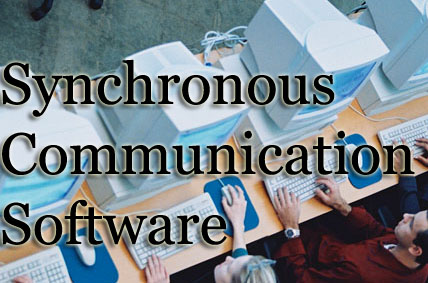ETAP 529 Introduction to Distance Learning
University at Albany
Professor Virginia Yonkers
Spring 2008Technology Group 4: Abigail Moskovits, Tom Cutonilli, Anne Canale Stalnecker
Table of Contents > Introduction > SCS Technologies > Appropriate Uses & Limitations >Support & Costs> References Synchronous Communication Software (SCS) Technologies
Instant Messaging (IM) and Chat
Instant Messaging and Chat are synchronous communication software tools that allow for instant, real-time interactivity between two or more people via the Internet and/or other technology tools (cell phone, Blackberry, etc.) In the early days of the Internet, people connected and communicated with each other online using the Internet Service Providers (ISPs) that were available at that time, such as America Online, Prodigy and CompuServe. Chat rooms soon followed in the early 1990s. Instant Message and Chat are similar, but IM conversations are limited to two people and the Chat can involve many more in the online discussion. IM first became popular as a social networking communication tool, but soon made its way intot the business and education world.
The most popular commercial IM/Chat services are Windows Live, Yahoo Messenger and AOL Instant Messenger (AIM). Additionally, there are many learning management systems (LMS) and classroom management systems (CMS) used in higher education that have internal Chat functions (e.g., Angel's LIVE and Blackboard's Chat). Aside from basic IM and Chat functions, most commercial Instant Messaging software programs provide additional features such as the ability to videoconference, share web links, view images, listen to audio, and share documents. The IM/chat community even has its own dictionary of acronyms used in online discussions.IM/Chat is a tool that is not only understood by youths today, but also enjoyable for them; it is a natural part of how young people communicate, and a critical component of their social culture. Kleimann (2004) sums up this culture well, stating "Having grown up in a technology-rich world in which the Internet, email, instant messaging, cell phones, DVDs, and digital music are part of their experience from childhood, these students view information, communication, and community very differently from prior generations. In their experience, information on any topic is easily available and free, communication via instant messaging, email, and cell phone is embedded throughout their days, and community does not depend upon physical proximity—they find it natural to participate in online communities formed by people with common interests who they have never met in person. They are interested the world around them, view the world as far smaller than prior generations did, and are optimistic about their futures (Kleimann, 2004)".
Videoconferencing
The early forms of distance education missed an important element: the "lack of a 2-way communications channel between teacher and student." Learning at a distance through videoconferencing addresses this issue. Videoconferencing can be successfully executed "with 1- or 2-way video and 2-way audio broadcast, cable, telephone, fiber optics, satellite, microwave, closed-circuit or low power television" (Sherry, 1996).Constructivist theorists would see videoconferencing as the ideal learning situation as it is both social and provides for physical interaction. These social and physical elements combine to help define problems and find solutions. According to Sherry, ". . . to implement constructivism in a lesson, one must shift one’s focus away from the traditional transmission model to one which is more complex, interactive, and evolving" (Sherry, 1996). A videoconference is certainly interactive, it is complex, and it is forever being updated to meet the demands of our developing, technology-saturated 21st century.
According to Sherry who quotes Schlosser and Anderson, ". . . the distance learning system must artificially recreate the teaching-learning interaction and re-integrate it back into the instructional process." A videoconference is the form of distance learning that most closely resembles face-to-face learning’s teaching-learning interaction. Hilary Perraton believes that distance learning is effective when the instructor "meets the distance students face-to-face". It is only then that the teacher "becomes a facilitator of learning, rather than a communicator of a fixed body of knowledge" (Perraton, 1988).
Other forms of SCS
Another form of synchronous technology is computer-to-computer calling system such as Skype, which provides the ability for different parties to talk to each other via the Internet to other Skype users (the computer operates as a telephone). Instant Messaging software can provide streaming content (real-time news/stock information), and the capability to send IMs from the computer to cell phone and from cell phone to computer--all very popular means of communication.Synchronous communication tools are embedded in our culture, and have become an integral part of the way we communicate and interact in this digital era.
Next page > Top of Page > Table of Contents
Technology Group 4: Abigail Moskovits, Tom Cutonilli, Anne Canale Stalnecker
ETAP 529 Introduction to Distance Learning
Professor Virginia Yonkers
University at Albany
Spring 2008Updated 29-Feb-2008
